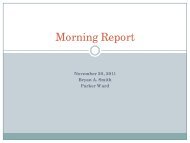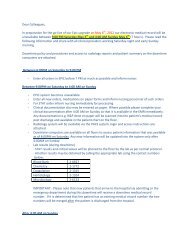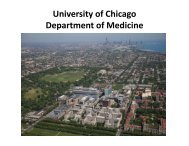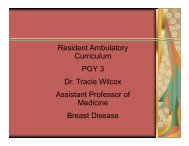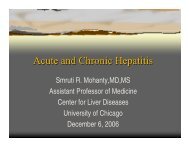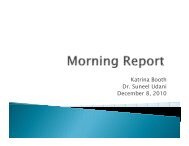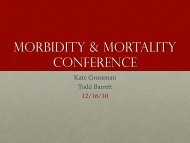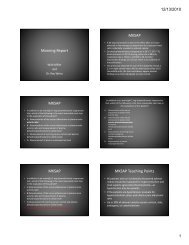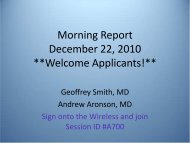Morning Report 11.1.10 g p
Morning Report 11.1.10 g p
Morning Report 11.1.10 g p
Create successful ePaper yourself
Turn your PDF publications into a flip-book with our unique Google optimized e-Paper software.
<strong>Morning</strong> g <strong>Report</strong> p <strong>11.1.10</strong><br />
Lindsay Petty
The Case<br />
22 yo F with h/o HIV, feels like it is hard to<br />
breathe.
Except<br />
You aren’t in Chicago.<br />
You are in . . .
Lesotho<br />
www.worldatlas.com
Most of the Country
Baylor Clinical Center of Excellence
The Medical Record<br />
Bukanas!
Mokhotlong<br />
The Loneliest Place on Earth
Queen Elizabeth II Hospital<br />
(Not allowed to take pictures)
Back to the Case . . .<br />
22 yo HIV+ F feels like it is hard to breathe.<br />
What would you like to know?
HPI<br />
• 1.5 months increasing SOB and DOE<br />
• C Can only l walk lk a f few steps t without ith t SOB<br />
• 20 lb weight loss<br />
• Subjective fevers<br />
• Night sweats<br />
• Malaise<br />
• Weakness<br />
• Orthopnea<br />
• PND<br />
• Was seen in clinic 3 yrs ago, dx’ed with HIV, didn’t f/u.
Past Medical History<br />
• Past Med Hx:<br />
– HIV, CD4 unknown at present<br />
• Past Surgical Hx:<br />
– None<br />
• Medications:<br />
– None<br />
• Allergies:<br />
– NKDA<br />
• Fam Hx:<br />
– Mother passed away. Father unknown. Maternal grandparents are<br />
healthy healthy.<br />
• Social Hx:<br />
– Multiple male partners.
What is your differential at this point?
Cardiac:<br />
-CHF<br />
DDx: DOE of Gradual Onset<br />
-High output heart failure<br />
-Pericardial Effusion<br />
-Valvular dysfunction<br />
-Cardiomyopathy y p y ( (Dilated or Restrictive) )<br />
-Myocarditis (viral vs. nonviral<br />
-Eisenmenger’s Syndrome<br />
ID:<br />
-TB<br />
-PCP<br />
-Myocarditis<br />
Myocarditis<br />
-Pericarditis: TB, Coxsackie, EBV, etc<br />
-Sepsis<br />
-MAI<br />
-Fungal pneumonia<br />
-Endocarditis: Bacterial or Fungal<br />
Respiratory:<br />
-Pulmonary Infection<br />
-COPD<br />
-Asthma<br />
-Pleural effusion<br />
-Lung g tumor<br />
-Pulmonary HTN<br />
-ILD<br />
-LIP<br />
GI:<br />
-Ascites Ascites<br />
-Liver disease<br />
Neuro:<br />
-Neuromuscular dz<br />
Other:<br />
-Pregnancy<br />
-Carbon monoxide poisoning<br />
-Obesity<br />
-Altitude<br />
Endo:<br />
-Hypothyroidism<br />
Heme/Onc:<br />
-Anemia<br />
-Malignancy: lung, lymphoma<br />
causing tracheal compression,<br />
cardiac tumor<br />
-Thromboembolism<br />
Renal:<br />
-Nephrotic syndrome<br />
-ESRD 2/2 HIV nephropathy
Cardiac:<br />
-CHF<br />
DDx: DOE of Gradual Onset<br />
-High output heart failure<br />
-Pericardial Effusion<br />
-Valvular dysfunction<br />
-Cardiomyopathy y p y ( (Dilated or Restrictive) )<br />
-Myocarditis (viral vs. nonviral)<br />
-Eisenmenger’s Syndrome<br />
ID:<br />
-TB<br />
-PCP<br />
-Myocarditis<br />
Myocarditis<br />
-Pericarditis: TB, Coxsackie, EBV, etc<br />
-Sepsis<br />
-MAI<br />
-Fungal pneumonia<br />
-Endocarditis: Bacterial or Fungal<br />
Respiratory:<br />
-Pulmonary Infection<br />
-COPD<br />
-Asthma<br />
-Pleural effusion<br />
-Lung g tumor<br />
-Pulmonary HTN<br />
-ILD<br />
-LIP<br />
GI:<br />
-Ascites Ascites<br />
-Liver disease<br />
Neuro:<br />
-Neuromuscular dz<br />
Other:<br />
-Pregnancy<br />
-Carbon monoxide poisoning<br />
-Obesity<br />
-Altitude<br />
Endo:<br />
-Hypothyroidism<br />
Heme/Onc:<br />
-Anemia<br />
-Malignancy: lung, lymphoma<br />
causing tracheal compression,<br />
cardiac tumor<br />
-Thromboembolism<br />
Renal:<br />
-Nephrotic syndrome<br />
-ESRD 2/2 HIV nephropathy
Physical Exam<br />
• Vitals: T 38.0 P 105 BP 105/65 RR 24 SpO2 96% RA<br />
• General: NAD, cachetic, speaking in sentences<br />
• HEENT: PERRL, EOMI, anicteric sclera, MMM, no cervical<br />
LAD<br />
• Cardiac: regular rhythm, distant heart sounds, no S3 or<br />
S4, , no murmurs, , no rubs, , JVD ~8cm, , neg g hepatojugular<br />
p j g<br />
reflex, 2+ pulses, < 2 sec capp refill, no LE edema<br />
• Resp: Bibasilar inspiratory crackles<br />
• Abd: soft, NT, ND, normoactive BS, no HSM<br />
• Neuro: CN II-XII grossly intact, 2+ reflexes
What labs and test would you need?<br />
What labs would you like?
Initial Labs and Tests<br />
• In Lesotho . . . • At UofC . . .
Initial Labs and Tests<br />
• In Lesotho . . . • At UofC . . .<br />
– CBC<br />
– LFTs<br />
– Bcx x 2<br />
– UA<br />
– Ucx<br />
– Fungal bcx<br />
– AFB bcx<br />
– BNP<br />
– Ddimer<br />
– Cardiac Enzymes<br />
– B-HCG<br />
– Histo ag<br />
Blasto ab<br />
– Blasto ab<br />
– Strep pneumo ag<br />
– Legionella ag<br />
– RVP<br />
– ABG<br />
– TSH<br />
– AFB x 3<br />
– PPD/Quantiferon Gold<br />
– Lymphocyte subsets<br />
– Viral load<br />
– HIV genotype<br />
– CXR<br />
– EKG<br />
– TTE<br />
– Chest CT- PE protocol vs. High Res ILD protocol<br />
– ?Bronch? With PCP
Initial Labs and Tests<br />
• In Lesotho . . .<br />
– Hemoglobin<br />
–CBC<br />
– LFTs<br />
– CD4 count<br />
– AFB x 3<br />
–CXR<br />
• At UofC . . .<br />
– CBC<br />
– LFTs<br />
– Bcx x 2<br />
– UA<br />
– Ucx<br />
– Fungal bcx<br />
– AFB bcx<br />
– BNP<br />
– Ddimer<br />
– Cardiac Enzymes<br />
– B-HCG<br />
– Histo ag<br />
– Blasto ab<br />
– Strep pneumo ag<br />
– Legionella ag<br />
– RVP<br />
– ABG<br />
– TSH<br />
– AFB x 3<br />
– PPD/Quantiferon Gold<br />
– Lymphocyte subsets<br />
– Viral load<br />
– HIV genotype<br />
– CXR<br />
– EKG<br />
– TTE<br />
– Chest CT- PE protocol vs. High Res ILD protocol<br />
– ?Bronch? With PCP
Results<br />
11.0 6.0 2.9<br />
3.0 198<br />
33.4<br />
CD4 Pending<br />
0.4<br />
25 22<br />
AFBs being brought to the hospital<br />
90<br />
Going to the hospital for her CXR . . .
Subsequent Labs and Tests<br />
• In Lesotho . . . • At UofC . . .
Subsequent Labs and Tests<br />
• In Lesotho . . .<br />
– TTE<br />
• At UofC . . .<br />
– TTE
Echo showed . . .<br />
• Pericardial effusion<br />
•Fibrin b strands st a ds in pericardial pe ca d al space<br />
What do you want to do?
Idiopathic:<br />
DDx: Pericardial Disease<br />
-Often presumed to have viral or<br />
autoimmune etiology, but no<br />
cause found.<br />
Cardiac:<br />
-Early Early infarction pericarditis<br />
-Late postcardiac injury syndrome<br />
-Myocarditis<br />
-Dissecting Aortic Aneurysm<br />
Infections:<br />
Heme/Onc:<br />
-Radiation<br />
-Neoplasms<br />
-Metastatic- lung or breast CA,<br />
Hodgkins’s, leukemia, melanoma<br />
-Primaryy<br />
- Rhado, teratoma, fibroma,<br />
Lipoma, leiomyoma, angioma<br />
-Paraneoplastic<br />
Autoimmune:<br />
-Rheumatic disease<br />
- Lupus, RA, Vasculitis, scleroderma,<br />
MCTD<br />
-Other<br />
- Wegener’s, Wegener s, polyarteritis nodosa,<br />
sarcoidosis, IBD, Whipple’s,<br />
Giant cell arteritis, Rheumatic<br />
Fever<br />
-Viral: Coxsackievirus, echovirus, adeno, EBV, CMV, Flu, Varicella, Rubella, HIV, HepB, Mumps,<br />
Parvovirus B19<br />
-Bacterial: Staph, Strep, pneumococcus, Haemophilus, Neiserria, Chlamydia, Legionella, TB,<br />
Salmonella, Lyme<br />
-Mycoplasma<br />
-Fungal: Histo Histo, Aspergillosis Aspergillosis, Blasto Blasto, coccidio coccidio, actinomycosis, actinomycosis nocardia, nocardia candida<br />
-Parasitic: Echinococcus, amebiasis, toxoplasmosis<br />
-Infective Endocarditis w ring abscess<br />
Up To Date<br />
Trauma:<br />
-Blunt<br />
-Penetrating<br />
-Iatrogenic
Pericardiocentesis<br />
Can be both diagnostic and therapeutic<br />
therapeutic.<br />
Wh What tests would ld you send?<br />
d?
Pericardial Fluid . . .<br />
• AFB smears sent--> sent > negative<br />
• Oh Other tests you can send: d<br />
– AFB culture (more often positive but rarely<br />
sent i in resource-limited li i d settings) i )<br />
– Cell count/diff: bloody, high protein,<br />
elevated l t d lleukocyte k t (l (lymphocyte h t or<br />
monocyte)<br />
– Adenosine Deaminase levels<br />
–PCR
Adenosine Deaminase<br />
• ADA: enzyme marker of cell-mediated immune<br />
response activity to M tuberculosis, includes T-cell and<br />
Macrophages<br />
• Elevated levels both sensitive and specific for TB<br />
• In pericardial fluid, fluid small study with 20 cases:<br />
• Mean level 92, range 35-135 (nml 0-18)<br />
• Sensitivity 100% and Specificity 83.3%, p40<br />
• Sensitivity and Specificity, 88% and 83%<br />
Arroyo M, Soberman JE. Adenosine deaminase in the diagnosis of tuberulous pericardial effusion. Am J Med Sci. 2008 Mar;335(3):227-9.<br />
Tuon FF, et al. ADA and tuberculous pericarditis—a systematic review with meta-analysis. Acta Trop. 2006 Aug; 99(1):67-74.<br />
Marthur PC, et al. Diagnostic Value of ADA Activity in Tubercular Serositis. Indian J Tuberc 2006;53:92-95.
Tuberculous Pericarditis<br />
• Most common pericardial disease in Sub-<br />
Saharan Africa<br />
• Present as:<br />
– Pericardial effusion<br />
– Constrictive pericarditis<br />
– Cardiac tamponade<br />
• Pericardial disease<br />
– In developed world, < 5% d/t TB<br />
– SSub-Saharan b S h Af Africa, i 50 50-70% 70% d/t TB<br />
– TB accounts for 96-100% of cases in HIV+
HIV and TB Co-infection<br />
• TB increases viral replication in HIV<br />
• Lesotho: 4th highest incidence of TB<br />
in the world: 602 cases/100,000 cases/100 000 in<br />
2005<br />
• 88% of f TB TB-infected i f d adults d l HIV HIV+ i in<br />
Lesotho<br />
Coovadia, HM, et al. Childhood human immunodeficiency virus and TB co-infections: reconciling conflicting data. Int J Tuberc Lung Dis 2 (1998), 844-851.<br />
Gray D, et al. Low Rates of Hepatotoxicity in HIV-infected Children on Anti-retroviral Therapy With and Without Isoniazid Prophylaxis.<br />
Journal of Tropical Pediatrics. Epub Aug 26.<br />
Clinical Practice Guidelines for Pediatric HIV Care: Lesotho COE. July 2009 (2.2)
Medical Management<br />
How would you treat?
TB Treatment in Lesotho<br />
Intensive Phase: 2 months<br />
Continuation Phase: 4 months<br />
Clinical Practice Guidelines for Pediatric HIV Care: Lesotho COE. July 2009 (2.2)
Steroids?<br />
• Systematic review of randomized control trials<br />
• Four trials with 469 participants.<br />
• Three (N=411) tested adjuvant steroids in<br />
participants with suspected TB pericarditis in<br />
the pre-HIV era.<br />
• Fewer participants died in intervention group,<br />
but not statistically significant.<br />
– RR 0.50, 050 95% CI 019128 0.19-1.28; p=0.15 015<br />
• But, not done in setting of HIV. Need larger<br />
placebo controlled trials trials.<br />
Ntsekhe M et al. Adjuvant corticosteroids for tuberculous pericarditis promising, but not proven.<br />
Q J Med. 2003;96: 593-599.
What about HAART?<br />
• If already on ARV . . . Continue it, but<br />
think about drug interactions.<br />
• CD4 < 200: Start ARV 22-8 8 weeks after<br />
initiation of ATT<br />
• CD4 200 200-350: 350 CConsider id ARV<br />
• CD4 > 350: Defer ARV
CXR Findings<br />
•Enlarged g cardiac silhouette<br />
• Cardiac shadow globular with<br />
distinct margins<br />
• Cardiothoracic ratio exceeding 0.55<br />
• Active pulmonary TB in 30% patients<br />
Reuter H et al. Role of chest radiography in diagnosing patients with tuberculosis pericarditis. Cardiovasc JS Afr. 2005 Mar-Apr; 16(2): 108-11.
• Pericardial<br />
• Pleural<br />
•Meningitis<br />
• Lymph node<br />
• Intra-abdominal<br />
• Skeletal<br />
Extrapulmonary TB<br />
Clinical Practice Guidelines for Pediatric HIV Care: Lesotho COE. July 2009 (2.2)<br />
Cruz AT, Starke Jr. Clinical manifestations of tuberculosis in children. Paediatric Respiratory Reviews 2007; 8: 107-117.<br />
Marais, BJ et al. A refined symptom-based approach to diagnose tuberculosis in children. Pediatrics. 2006; 118(5): e1350-9.
• Who matters?<br />
– Household contacts<br />
TB Contacts<br />
– Smear +<br />
– Timing: within a year<br />
– C Contacts with i h prolonged l d f fever, cough, h or weight i h lloss<br />
• Get sputum smears on them if possible (early<br />
morning, fasting)<br />
Clinical Practice Guidelines for Pediatric HIV Care: Lesotho COE. July 2009 (2.2)
Case Follow-up<br />
• Started on 4-drug ATT<br />
• Given Gve a couse course o of steods steroids<br />
• Plan to start on ARV soon<br />
• And the CXR a couple weeks later . . .
MKSAP<br />
A 32-year-old man is evaluated for a fever 4 weeks after receiving a<br />
new diagnosis g of pulmonary p y tuberculosis and late-stage g HIV<br />
infection (CD4 cell count of 10/µL and an HIV RNA viral load of<br />
700,000 copies/mL). A four-drug antituberculosis regimen<br />
consisting of isoniazid, rifabutin, pyrazinamide, and ethambutol<br />
and an antiretroviral regimen g consisting g of tenofovir, ,<br />
emtricitabine, and lopinavir/ ritonavir are initiated.<br />
On physical examination, temperature is 38.3 °C (101.0 °F); the<br />
remaining vital signs are normal. normal There is an enlarged enlarged, fluctuant fluctuant,<br />
and tender right cervical lymph node that was not present 4 weeks<br />
ago. The skin, mucosal, and cardiopulmonary examinations are<br />
normal, and there is no evidence of hepatosplenomegaly.<br />
A repeat CD4 cell count at today’s visit is 130/µL, and the HIV RNA<br />
viral load is 2000 copies/mL. A chest radiograph is normal.
MKSAP<br />
Which of the following g is the most likely y<br />
diagnosis?<br />
A. Hodgkin lymphoma<br />
B B. Immune Imm ne reconstitution reconstit tion inflammatory<br />
inflammator<br />
syndrome<br />
C. Kaposi sarcoma<br />
D. Non-Hodgkin lymphoma
MKSAP<br />
Which of the following g is the most likely y<br />
diagnosis?<br />
A. Hodgkin lymphoma<br />
B B. Immune Imm ne reconstitution reconstit tion inflammator<br />
inflammatory<br />
syndrome<br />
C. Kaposi sarcoma<br />
D. Non-Hodgkin lymphoma
Key Points<br />
• Immune reconstitution inflammatory syndrome presents as a paradoxical<br />
deterioration in the clinical status of a patient with HIV infection after<br />
iinitiation iti ti of f highly hi hl active ti antiretroviral ti t i l th therapy. MMost t cases of f IRIS ddevelop l<br />
within a few weeks to a few months of commencement of HAART.<br />
• IRIS can present in two different situations:<br />
– an exacerbation of a partially or successfully treated opportunistic<br />
infection<br />
– a previously undiagnosed or subclinical infection.<br />
• The signs and symptoms of tuberculous IRIS may include high fevers, new<br />
or worsening lymphadenopathy, worsening of pulmonary symptoms, and a<br />
new or increasing pleural effusion. Principles of management include<br />
consideration of temporary HAART cessation in patients in whom<br />
potentially ll life-threatening l f h f forms of f IRIS S develop, d l such h as in those h with h<br />
severe neurologic disease. Most patients with IRIS are managed with<br />
antimicrobial therapy to reduce the antigen load of the triggering<br />
pathogen, short-term therapy with NSAIDs or corticosteroids to decrease<br />
inflammation inflammation, and HAART continuation<br />
continuation.
Key Points<br />
• Lymphoma does not typically present with the sudden appearance<br />
of tender, , fluctuant lymphadenopathy. y p p y Furthermore, , the temporal p<br />
association of fever and lymphadenopathy with HAART initiation in<br />
a patient with known tuberculosis is most consistent with IRIS.<br />
• Kaposi sarcoma can affect any organ in the body, body including the<br />
lymph nodes. However, Kaposi sarcoma typically affects the lower<br />
extremities, face, oral mucosa, genitalia, gastrointestinal tract,<br />
and lungs.<br />
• The optimal time for initiation of antiretroviral therapy during<br />
tuberculosis treatment is currently unknown. Current guidelines<br />
suggest gg waiting g 4 to 8 weeks before initiating g HAART. Patients<br />
already receiving HAART when antituberculosis treatment is<br />
started require a careful assessment to evaluate for potential<br />
drug-drug interactions.
Thanks!
Malnutrition: TTL



